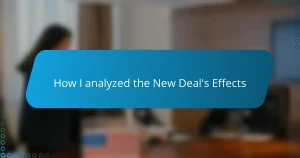Key takeaways
- The Marshall Plan provided over $12 billion in aid to Europe, aiming to rebuild economies and prevent communist influence post-WWII.
- It fostered cooperation among European nations, laying the groundwork for future institutions like NATO and the EU.
- The Plan emphasized the interconnectedness of economic recovery and political stability, highlighting strategic U.S. interests alongside humanitarian efforts.
- Lessons from the Marshall Plan include the importance of combining aid with political objectives and rebuilding trust among nations for lasting peace.
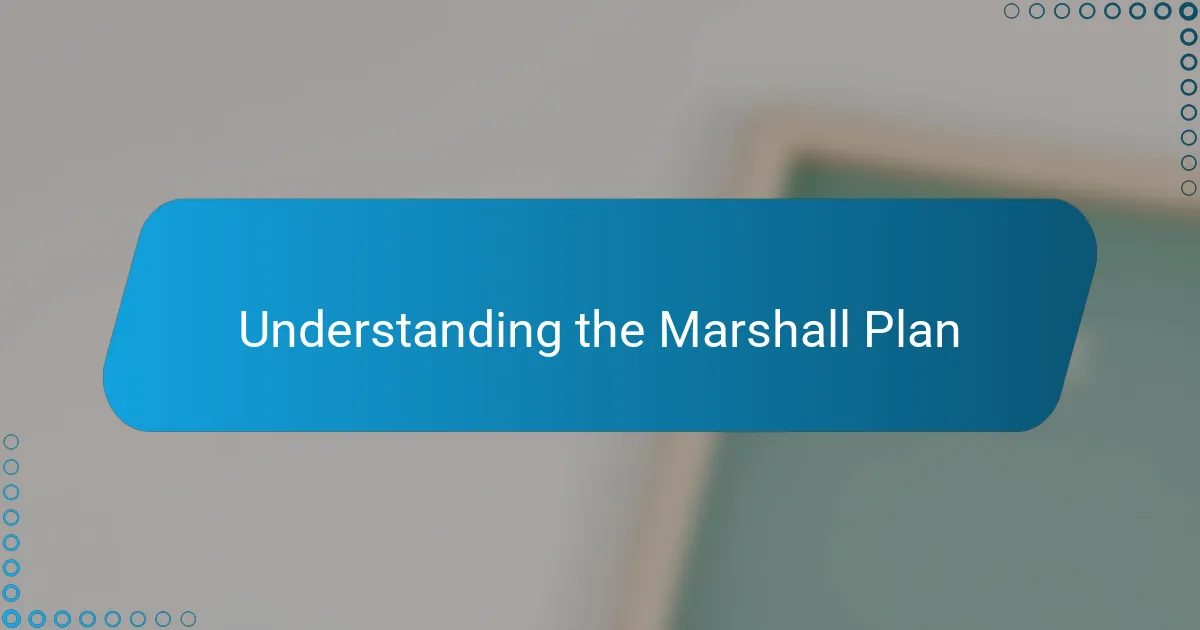
Understanding the Marshall Plan
The Marshall Plan was a massive American initiative to aid Western Europe’s recovery after the devastation of World War II. I remember first learning about it in college, and it struck me how this financial support wasn’t just about rebuilding infrastructure—it was about restoring hope and stability in a fractured world.
What fascinated me most was how the plan combined humanitarian aid with strategic interests, shaping not only the economies but also the political landscape of Europe. The idea that economic recovery could serve as a bulwark against the spread of communism made me realize just how interconnected politics and economics really are.
Key aspects of the Marshall Plan:
– Provided over $12 billion (around $130 billion today) in economic assistance to help rebuild European countries
– Aimed to revive industry and agriculture to prevent economic collapse
– Encouraged cooperation among European nations to promote stability
– Helped contain Soviet influence during the early Cold War period
– Laid groundwork for future institutions like NATO and the European Union
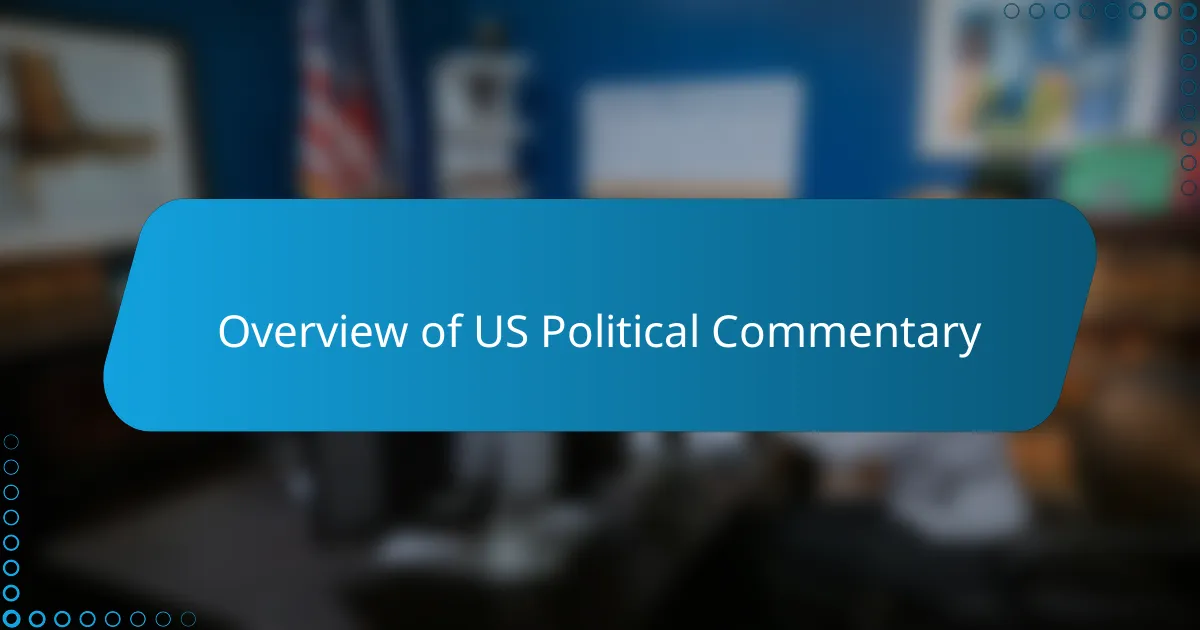
Overview of US Political Commentary
US political commentary often dives deep into historical policies to explain current dynamics, and the Marshall Plan is no exception. When I first examined this topic, I was struck by how much understanding one event could illuminate ongoing debates around foreign aid and American global strategy.
In reflecting on the Marshall Plan’s influence, I realized it’s more than just a historical footnote; it’s a lens through which we can see the interplay between economics and politics. Here are some key aspects often highlighted in political commentary:
- The Marshall Plan as a strategic tool for containing Soviet influence during the Cold War
- Its role in revitalizing Western European economies and fostering US-European alliances
- Debates about the Plan’s legacy in shaping America’s approach to international aid and diplomacy
- How commentators connect it to contemporary foreign policy decisions and political ideologies
- The emotional and political significance it carries for understanding US commitments abroad
I found that appreciating these points helped me engage more deeply with both historical and current political discussions.
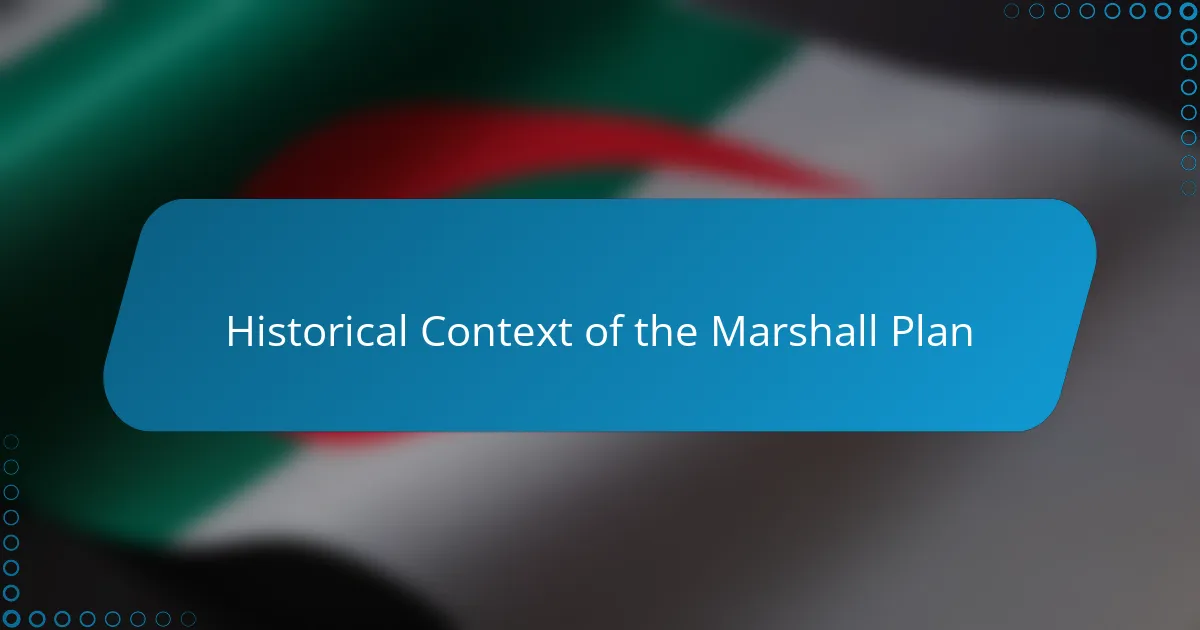
Historical Context of the Marshall Plan
The Marshall Plan emerged in the aftermath of World War II, at a time when Europe lay in ruins and the threat of communism was rising rapidly. From my research, I understand that the U.S. saw not just an opportunity to rebuild Europe physically, but also to secure political stability through economic aid. It’s remarkable how this strategy wasn’t just about dollars and cents, but about shaping the post-war world’s ideological landscape.
Reflecting on the period, it feels like the Marshall Plan symbolized more than aid—it was an expression of hope and commitment. Knowing this deeper historical context made me realize how the U.S. leadership carefully balanced generosity with strategic interests.
- Initiated in 1948, officially called the European Recovery Program
- Provided over $12 billion (about $130 billion today) in aid to European countries
- Aimed to rebuild war-torn economies to prevent communist influence
- Encouraged cooperation among European nations, sowing seeds for future integration
- Helped revive industries, infrastructure, and agriculture across participating countries

Impact of the Marshall Plan on US Politics
The Marshall Plan wasn’t just an economic recovery tool; it reshaped the political landscape in the US profoundly. From my research, I saw how it reinforced bipartisan cooperation at a time when Cold War tensions were soaring, which is remarkable considering today’s often polarized climate. I felt a sense of admiration for how policymakers then united behind a vision of stability and democratic support abroad while fortifying America’s global leadership.
| Aspect | Marshall Plan Influence |
|---|---|
| Political Unity | Encouraged bipartisan support for foreign aid and anti-communism policies |
| Foreign Policy Shift | Marked transition from isolationism to active international engagement |
| Domestic Politics | Increased focus on economic strength as a pillar of national security |
| Cold War Strategy | Used as a tool to contain Soviet influence in Europe |
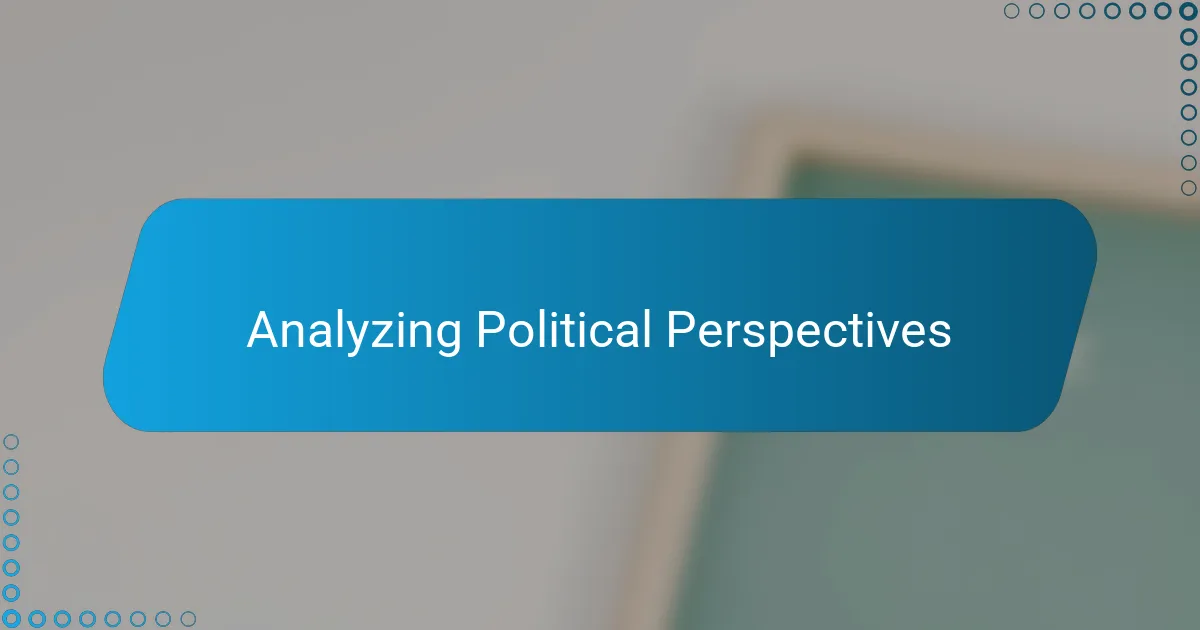
Analyzing Political Perspectives
When I dove into analyzing political perspectives on the Marshall Plan, I realized how much viewpoint shapes interpretation. Some see it purely as a humanitarian effort, while others emphasize its strategic Cold War role. This contrast made me wonder: how often do our political lenses color our understanding of history?
What struck me was how these perspectives reveal more about present concerns than past realities. For instance, conservatives might praise it as a bold stand against communism, while progressives could focus on its commitment to rebuilding and cooperation. I found this interplay fascinating because it highlights how history serves as a mirror for today’s political debates.
In my experience, unpacking these differing viewpoints isn’t just academic—it’s deeply personal. It challenged me to question my assumptions and appreciate the complexity behind political narratives. Have you ever noticed how one event can evoke such varied responses depending on who’s telling the story? That complexity is what makes political analysis both challenging and rewarding.
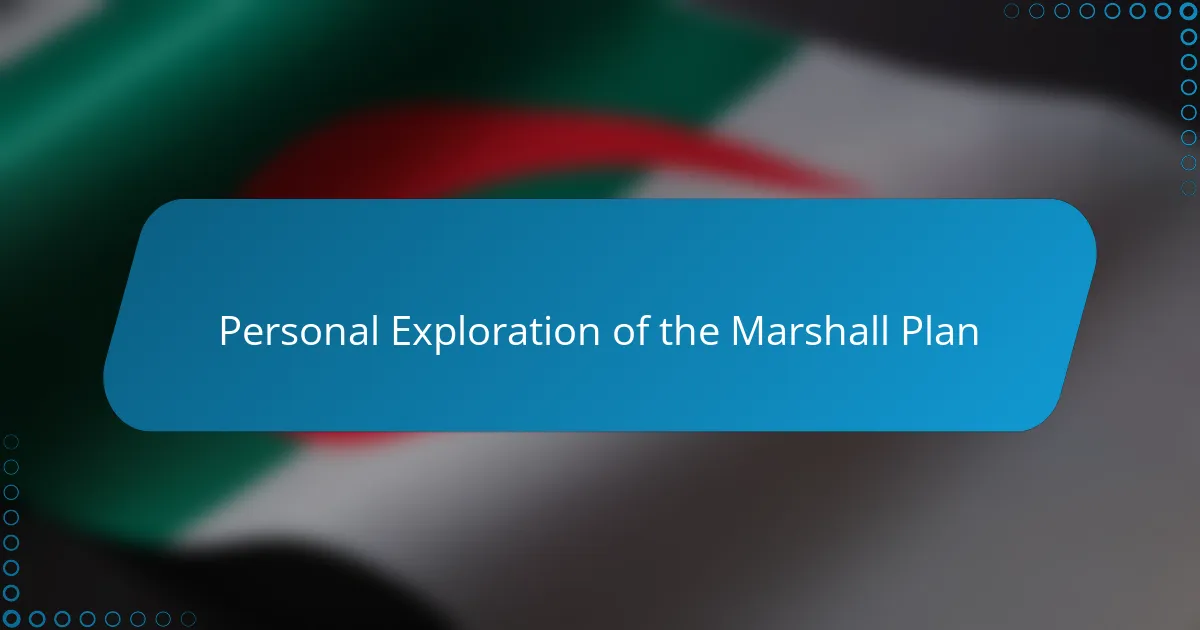
Personal Exploration of the Marshall Plan
Personal Exploration of the Marshall Plan
When I first delved into the Marshall Plan, I was struck by its ambitious scope and how it reshaped post-war Europe. It wasn’t just an economic aid package; it was a strategic move that balanced compassion with geopolitical foresight. Learning about the plan’s actual implementation made me appreciate how U.S. political leadership combined idealism with practical action during a critical moment in history.
| Aspect | Marshall Plan |
|---|---|
| Purpose | Rebuild war-torn Europe and prevent Soviet influence |
| Funding | Approximately $13 billion (1948-1952) |
| Impact | Revived European economies and strengthened alliances |
| My Reflection | Fascinated by how economic aid doubled as strategic diplomacy |
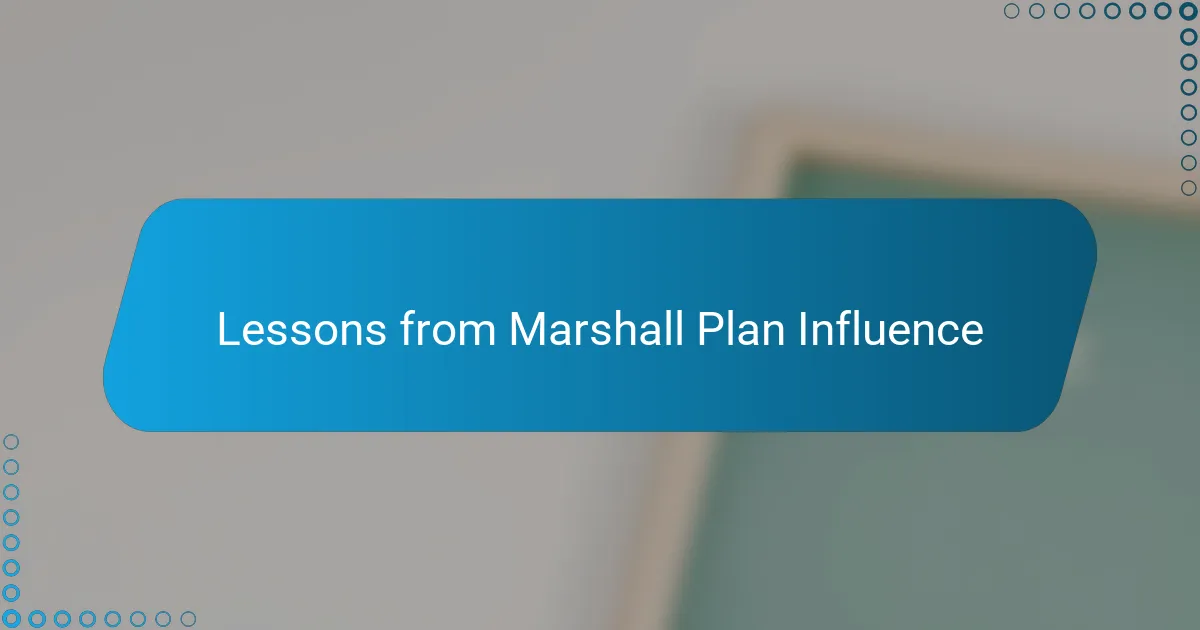
Lessons from Marshall Plan Influence
Reflecting on the Marshall Plan’s influence, I realize how deeply its lessons resonate even in today’s geopolitical strategies. The plan wasn’t just about economic aid; it was a masterclass in building alliances and fostering long-term stability. When I dove into the details, I was struck by how thoughtful and forward-looking American policymakers were in blending generosity with strategic intent.
From my perspective, the key takeaways from the Marshall Plan extend beyond economics to offer guidance on diplomatic engagement and resilience. Here’s what stood out most to me:
- The power of combining aid with clear political objectives to ensure sustainable outcomes
- The importance of rebuilding trust among former adversaries to create lasting peace
- The value of investing in infrastructure and human capital as pillars of recovery
- How economic stability can lay the groundwork for stronger democratic institutions
- The necessity of multilateral cooperation to amplify impact and share risks
These lessons remind me that successful foreign policy requires both heart and strategy, something I think is often overlooked in current debates.
